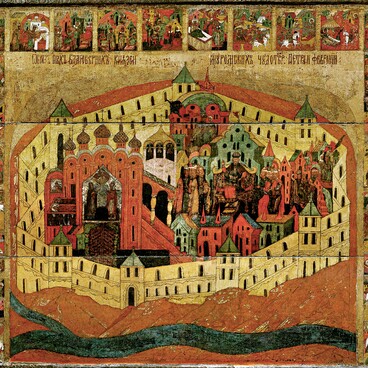The icon of Faithful Saints Prince Peter and Princess Fevronia of Murom was painted by an unknown artist in 1618. The image of pious spouses was specially created for the Church of Nativity of the Holy Virgin in Murom. The church was earlier the burial place for the relics of these saints. The icon was painted at the order of Andrey Palitsyn, the nephew of Avraamy Palitsyn, the cellarer of the Trinity-St. Sergius Monastery.
The literary source for the image was the Tale of Peter and Fevronia of Murom written by Ermolay-Erazm during the reign of tsar Ivan the Terrible. Ermolay-Erazm was a famous ecclesiastical writer and publicist. Metropolitan Macarius instructed him to write a novel about the Murom saints, as the church council of 1547 started the preparation for their canonization. Initially the novel was intended as prescribed reading for the festive vigil on the commemoration day of the Murom wonder workers.
Peter and Fevronia are portrayed in the middle of the icon in monk’s habit praying to Jesus. They are surrounded by thirty-two large marginal scenes. The holy faces of all the characters in the scenes are full of expression, figures are painted in much detail and gestures are eloquent.
The iconography of the image is non-traditional. The icon painter focused not as much on the details of the saints’ earthly life, as on glorifying and venerating them. The master created traditional life scenes using pictorial tools. He idealized his characters and removed from their life scenes all the episodes related to folklore motifs and alien to Christian world view.
A large part of the icon marginal scenes is devoted to church rites and sacraments — wedding, sacred processions, taking of monastic vows, funeral service, translation of relics. The iconography of these scenes often echoes other themes, such as the Entry into Jerusalem, Assumption, Meeting of the Icon of the Holy Virgin of Vladimir. A special place is given to miracles of blooming trees and joining the saints’ bodies in one sarcophagus.
The inscription has been preserved on the back of the icon: “This icon was delivered to the Murom cathedral church of the honorable and glorious Nativity of the Most Holy Theotokos, to the home of great wonder workers of Murom, Prince Peter and Princess Fevronia, by the sovereign”s military governor, humble servant Andrey Fedorov, son of Palitsyn, on the 13th day of March, 7126”.
The literary source for the image was the Tale of Peter and Fevronia of Murom written by Ermolay-Erazm during the reign of tsar Ivan the Terrible. Ermolay-Erazm was a famous ecclesiastical writer and publicist. Metropolitan Macarius instructed him to write a novel about the Murom saints, as the church council of 1547 started the preparation for their canonization. Initially the novel was intended as prescribed reading for the festive vigil on the commemoration day of the Murom wonder workers.
Peter and Fevronia are portrayed in the middle of the icon in monk’s habit praying to Jesus. They are surrounded by thirty-two large marginal scenes. The holy faces of all the characters in the scenes are full of expression, figures are painted in much detail and gestures are eloquent.
The iconography of the image is non-traditional. The icon painter focused not as much on the details of the saints’ earthly life, as on glorifying and venerating them. The master created traditional life scenes using pictorial tools. He idealized his characters and removed from their life scenes all the episodes related to folklore motifs and alien to Christian world view.
A large part of the icon marginal scenes is devoted to church rites and sacraments — wedding, sacred processions, taking of monastic vows, funeral service, translation of relics. The iconography of these scenes often echoes other themes, such as the Entry into Jerusalem, Assumption, Meeting of the Icon of the Holy Virgin of Vladimir. A special place is given to miracles of blooming trees and joining the saints’ bodies in one sarcophagus.
The inscription has been preserved on the back of the icon: “This icon was delivered to the Murom cathedral church of the honorable and glorious Nativity of the Most Holy Theotokos, to the home of great wonder workers of Murom, Prince Peter and Princess Fevronia, by the sovereign”s military governor, humble servant Andrey Fedorov, son of Palitsyn, on the 13th day of March, 7126”.



